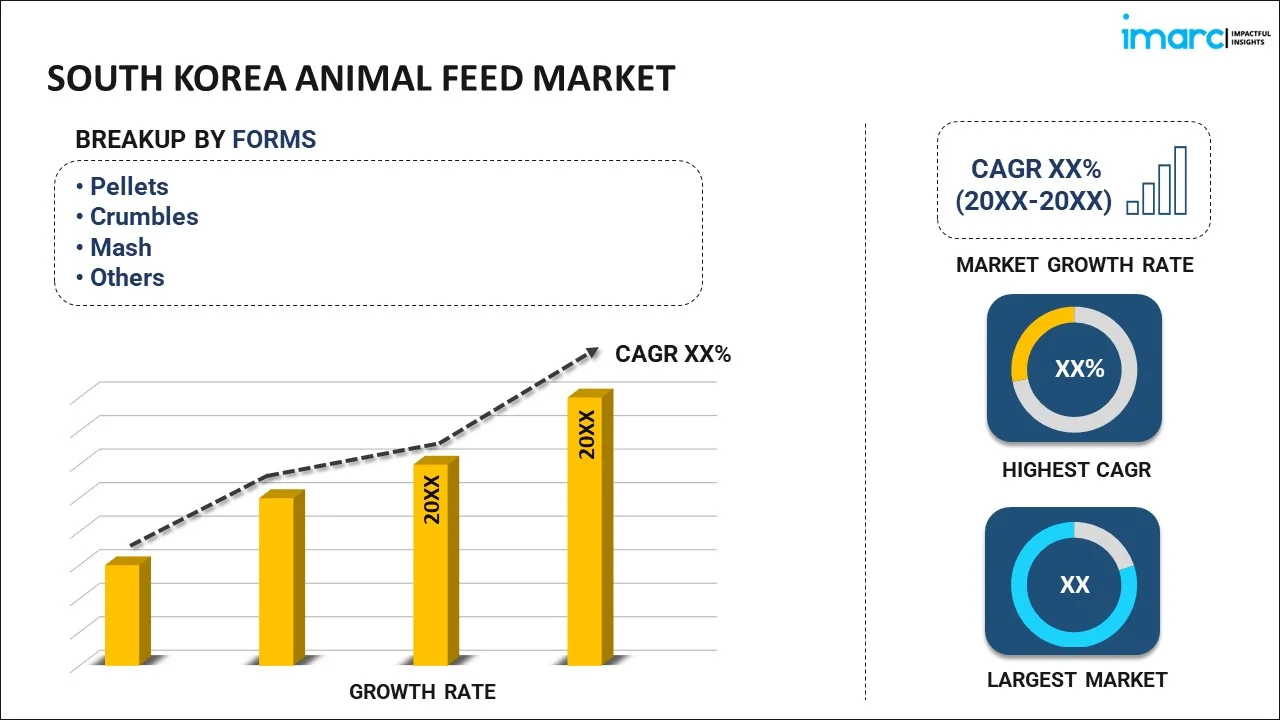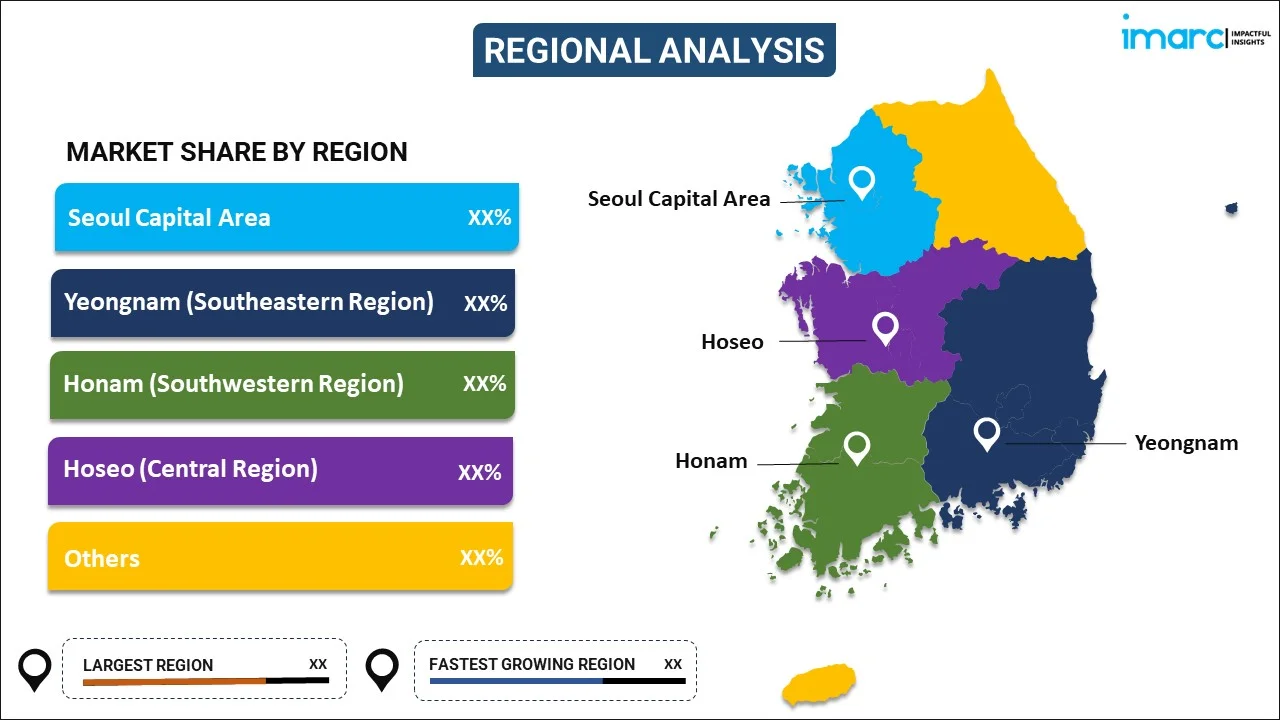
South Korea Animal Feed Market Report by Form (Pellets, Crumbles, Mash, and Others), Animal Type (Swine, Ruminants, Poultry, Aquaculture, and Others), Ingredient (Cereals, Oilseed Meal, Molasses, Fish Oil and Fish Meal, Additives, and Others), and Region 2025-2033
Market Overview:
The South Korea animal feed market size is projected to exhibit a growth rate (CAGR) of 2.39% during 2025-2033. The growing livestock sector, rising meat, dairy and eggs consumption, rapid technological advancements, increasing consumer awareness about the importance of animal welfare and sustainable farming practices, ongoing research and development represent some of the key factors driving the market.
|
Report Attribute
|
Key Statistics
|
|---|---|
|
Base Year
|
2024 |
|
Forecast Years
|
2025-2033
|
|
Historical Years
|
2019-2024
|
| Market Growth Rate (2025-2033) | 2.39% |
Animal feed is a crucial component in the agricultural and livestock industry, serving as the foundation for the well-being and productivity of animals raised for various purposes. It is a specialized mixture of ingredients designed to provide essential nutrients, vitamins, and minerals to animals, ensuring their growth, health, and overall performance. Animal feed typically comprises a blend of grains, such as corn, wheat, and barley, as well as protein sources like soybean meal, fishmeal, or meat and bone meal. These ingredients are carefully formulated to meet the specific dietary requirements of different animals, whether they are raised for meat, milk, eggs, or other products. The importance of high-quality animal feed cannot be overstated, as it directly impacts the animal's health and, consequently, the quality of the end products for human consumption. Adequate nutrition through well-balanced feed helps in optimizing animal growth rates, enhancing their immune system, and reducing the risk of diseases. Furthermore, animal feed plays a pivotal role in sustainable agriculture, as it allows for efficient resource utilization and minimizes the environmental footprint of livestock farming.
South Korea Animal Feed Market Trends:
The livestock sector of South Korea has been steadily expanding in recent years, driven by increasing demand for meat, dairy, and eggs. This growth is propelled by changing dietary habits and rising incomes, leading to a greater need for animal feed to support the larger livestock population. Additionally, as South Koreans consume more meat, especially pork and poultry, the demand for feedstock, such as corn and soybean meal, used in the production of animal feed has increased. This trend is in line with global patterns of increasing protein consumption. Other than this, environmental concerns and regulations related to livestock farming have become more stringent. This has prompted the adoption of sustainable feed production practices and innovations aimed at reducing the environmental footprint of the livestock sector. Besides this, South Korea relies on imports for a significant portion of its animal feed ingredients, including corn and soybean meal. International trade agreements and global commodity prices play a vital role in shaping the cost and availability of these ingredients. In line with this, the increasing consumer awareness about the importance of animal welfare and sustainable farming practices has led to a preference for products derived from animals raised on quality feed. This has encouraged livestock producers to source and use high-quality feeds. Furthermore, animal health and disease prevention are paramount in the livestock industry. Feed additives and supplements that enhance animal immunity and overall health are in demand, driving innovation in feed formulations. Apart from this, the South Korean animal feed industry has embraced technological advancements in feed formulation, production, and delivery. Modern feed mills employ automation and precision to produce high-quality, nutritionally balanced feeds efficiently. Moreover, environmental concerns and regulations related to livestock farming have become more stringent. This has prompted the adoption of sustainable feed production practices and innovations aimed at reducing the environmental footprint of the livestock sector.
South Korea Animal Feed Market Segmentation:
IMARC Group provides an analysis of the key trends in each segment of the market, along with forecasts at the country level for 2025-2033. Our report has categorized the market based on form, animal type, and ingredient.
Form Insights:

- Pellets
- Crumbles
- Mash
- Others
The report has provided a detailed breakup and analysis of the market based on the form. This includes pellets, crumbles, mash, and others.
Animal Type Insights:
- Swine
- Starter
- Finisher
- Grower
- Ruminants
- Calves
- Dairy Cattle
- Beef Cattle
- Others
- Poultry
- Broilers
- Layers
- Turkeys
- Others
- Aquaculture
- Carps
- Crustaceans
- Mackeral
- Milkfish
- Mollusks
- Salmon
- Others
- Others
A detailed breakup and analysis of the market based on the animal type have also been provided in the report. This includes swine (starter, finisher, and grower), ruminants (calves, dairy cattle, beef cattle, and others), poultry (broilers, layers, turkeys, and others), aquaculture (carps, crustaceans, mackeral, milkfish, mollusks, salmon, and others), and others.
Ingredient Insights:
- Cereals
- Oilseed Meal
- Molasses
- Fish Oil and Fish Meal
- Additives
- Antibiotics
- Vitamins
- Antioxidants
- Amino Acids
- Feed Enzymes
- Feed Acidifiers
- Others
- Others
The report has provided a detailed breakup and analysis of the market based on the ingredient. This includes cereals, oilseed meal, molasses, fish oil and fish meal, additives (antibiotics, vitamins, antioxidants, amino acids, feed enzymes, feed acidifiers, and others), and others.
Regional Insights:

- Seoul Capital Area
- Yeongnam (Southeastern Region)
- Honam (Southwestern Region)
- Hoseo (Central Region)
- Others
The report has also provided a comprehensive analysis of all the major regional markets, which include Seoul Capital Area, Yeongnam (Southeastern Region), Honam (Southwestern Region), Hoseo (Central Region) and Others.
Competitive Landscape:
The market research report has also provided a comprehensive analysis of the competitive landscape in the market. Competitive analysis such as market structure, key player positioning, top winning strategies, competitive dashboard, and company evaluation quadrant has been covered in the report. Also, detailed profiles of all major companies have been provided.
South Korea Animal Feed Market Report Coverage:
| Report Features | Details |
|---|---|
| Base Year of the Analysis | 2024 |
| Historical Period | 2019-2024 |
| Forecast Period | 2025-2033 |
| Units | Million USD |
| Scope of the Report | Exploration of Historical and Forecast Trends, Industry Catalysts and Challenges, Segment-Wise Historical and Predictive Market Assessment:
|
| Forms Covered | Pellets, Crumbles, Mash, Others |
| Animal Types Covered |
|
| Ingredients Covered |
|
| Regions Covered | Seoul Capital Area, Yeongnam (Southeastern Region), Honam (Southwestern Region), Hoseo (Central Region), Others |
| Customization Scope | 10% Free Customization |
| Post-Sale Analyst Support | 10-12 Weeks |
| Delivery Format | PDF and Excel through Email (We can also provide the editable version of the report in PPT/Word format on special request) |
Key Questions Answered in This Report:
- How has the South Korea animal feed market performed so far and how will it perform in the coming years?
- What has been the impact of COVID-19 on the South Korea animal feed market?
- What is the breakup of the South Korea animal feed market on the basis of form?
- What is the breakup of the South Korea animal feed market on the basis of animal type?
- What is the breakup of the South Korea animal feed market on the basis of ingredient?
- What are the various stages in the value chain of the South Korea animal feed market?
- What are the key driving factors and challenges in the South Korea animal feed?
- What is the structure of the South Korea animal feed market and who are the key players?
- What is the degree of competition in the South Korea animal feed market?
Key Benefits for Stakeholders:
- IMARC’s industry report offers a comprehensive quantitative analysis of various market segments, historical and current market trends, market forecasts, and dynamics of the South Korea animal feed market from 2019-2033.
- The research report provides the latest information on the market drivers, challenges, and opportunities in the South Korea animal feed market.
- Porter's five forces analysis assist stakeholders in assessing the impact of new entrants, competitive rivalry, supplier power, buyer power, and the threat of substitution. It helps stakeholders to analyze the level of competition within the South Korea animal feed industry and its attractiveness.
- Competitive landscape allows stakeholders to understand their competitive environment and provides an insight into the current positions of key players in the market.
Need more help?
- Speak to our experienced analysts for insights on the current market scenarios.
- Include additional segments and countries to customize the report as per your requirement.
- Gain an unparalleled competitive advantage in your domain by understanding how to utilize the report and positively impacting your operations and revenue.
- For further assistance, please connect with our analysts.
 Request Customization
Request Customization
 Speak to an Analyst
Speak to an Analyst
 Request Brochure
Request Brochure
 Inquire Before Buying
Inquire Before Buying




.webp)




.webp)












